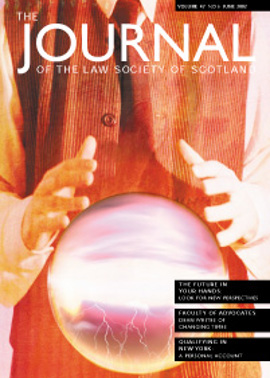In practice
This month, Bruce Ritchie, Director of Professional Practice at the Society, looks at common conflict of interest scenarios
The Solicitor’s (Scotland) Practice Rules 1986 (commonly known as the Conflict of Interest Rules) provide that a solicitor should not act for two or more parties whose interests conflict. In relation to conveyancing transactions the rules go further and provide that the same firm shall not act for buyer and seller; landlord and tenant; lender and borrower unless certain particular circumstances apply – e.g. the parties are related by blood, adoption or marriage or both are established clients. The Committee are frequently asked to consider how the rules apply to particular situations. These have recently included:
a. Conflict between seller and purchaser’s lender
A firm sought advice in relation to commercial securities. The Practice Guideline in 1994 (PH Book Vol 3 page F903) sets out the policy that the same firm should not act for lender and borrower in a commercial security unless it is regarded as de minimis. What is de minimis may vary from bank to bank, but £100,000 has been commonly accepted as the upper limit.
In transactions where the firm were already acting for the seller they had also been asked to act for the purchaser’s lender. The Committee agreed that although the Conflict of Interest Rules are silent on this specific relationship, there is such a significant potential for conflict of interest that it would be inappropriate for the same firm to act for a seller and for the lender to a purchaser.
b. Family transactions with a substantial element of gift
The Committee were asked to give a general view in relation to a number of different scenarios which had in common an element of gift either in whole or in part. The Committee declined to express a general view and – as with many other issues – agreed that the particular circumstances of each transaction need to be considered. It will be a matter of professional judgment for the solicitor in each case as to whether there is an actual conflict of interest and if in doubt solicitors should exercise caution before proceeding. It may be for example that what is being gifted is more of a liability than an asset, or it may be that the sellers within a family may not fully appreciate that a conveyance is for less than full market value. If asked to act (say) for parents and children on either side of a transaction for less than full market value it will be necessary to see each side on their own to ensure that they fully appreciate the nature of the transaction and are capable of giving proper instructions.
c. Spouses and guarantees
This has been the subject of previous articles in the Journal – particularly in the Risk Management column. The Professional Practice Committee is firmly of the view that there is an actual conflict of interest between spouses where one is being asked to guarantee a loan to the other or where the jointly owned matrimonial home is to be put up as security for a business loan to one of them. The same firm should not act for both spouses in these situations and if one of them refuses to get separate independent advice, the firm must advise that party in writing that signature of any document will have legal consequences and they should seek independent legal advice before signing it (Rule 7).
d. Commercial transactions
In relation to commercial transactions the Committee considered correspondence between two substantial city practices, particularly in relation to PFI or PPP projects. An example given was where a consortium and a bank in relation to a PPP project were both existing clients. They had appointed one firm to act in implement of the transaction where the funders had had separate legal advice on the format of the loan agreement. The Committee agreed that if the parties had had separate advice on the formation of the loan agreement, and were now seeking implement of it, there would only be a conflict of interest if a dispute arose. The Committee declined to issue guidelines on the matter and felt that solicitors must exercise professional judgment in each individual transaction. Both the Code of Conduct and the Practice Rules are clear that the same firm should not act for the parties where there is an actual conflict of interest. If solicitors are concerned there is a significant potential for conflict of interest it would be sensible to decline to act.
e. Rule 7 – Issuing document to unrepresented party for signature
A complaint was made against a firm who had accepted instructions from the disponee in a family transaction; had prepared the disposition and given it to their own client to be signed by her mother, the disponer, whom the solicitors knew was not represented by a solicitor. The Committee decided that the words “issued to him” in Rule 7 mean more than just issuing the document directly to the unrepresented party, and include using the solicitors own client as a means of transmitting a document to an unrepresented party for signature.
In this issue
- Opinion
- No room for complacency
- The future in your hands
- MDPs: why not?
- A bite out of the Big Apple
- Traps for clients and advisers
- Peer to peer websites – heathen chemistry?
- Legal services through a market lens
- Back on the case
- Website reviews
- Visions of a reasonable observer
- Professional risks – self assessment
- In practice
- Europe
- Plain speaking
- Book reviews






